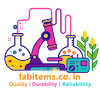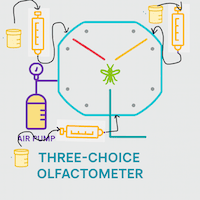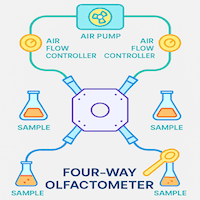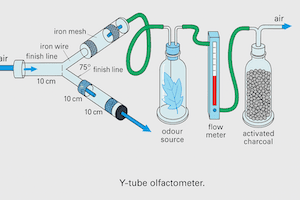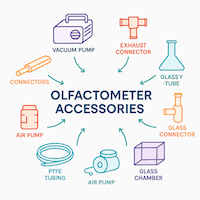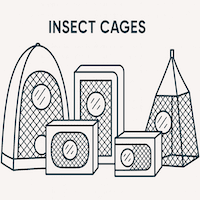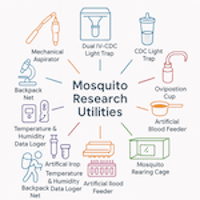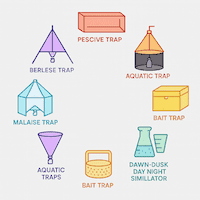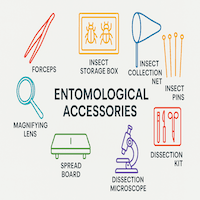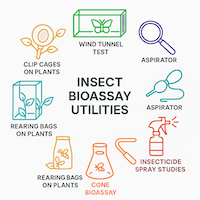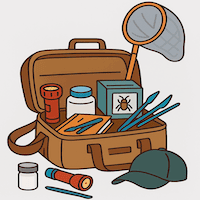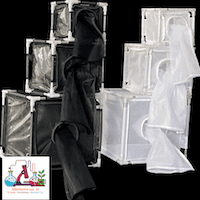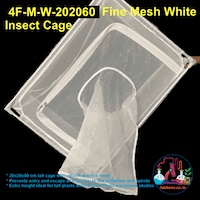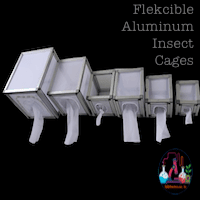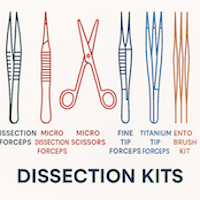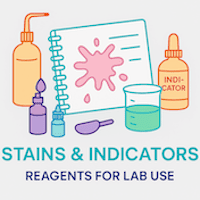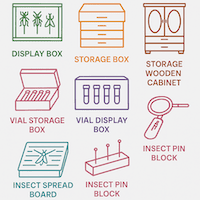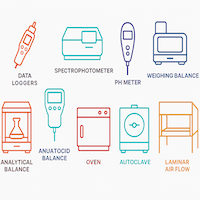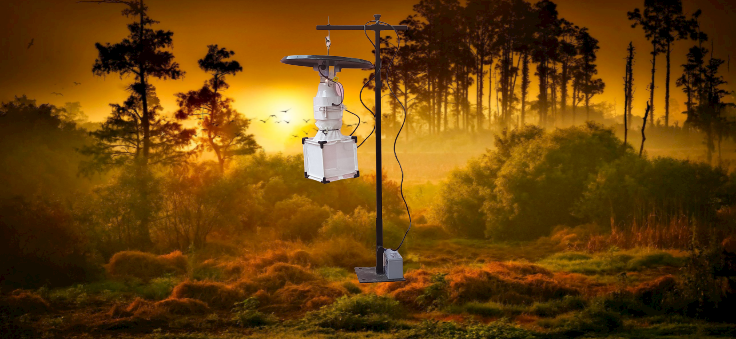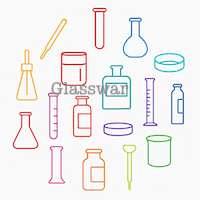Entomological Kits for Collection, Staging, Preserving and Recording Insects
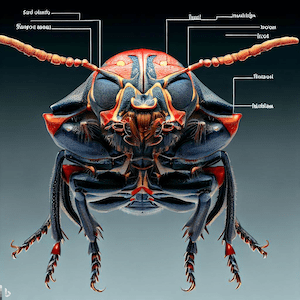
Benefits of Studying Insects
Insects are the most diverse group of animals on Earth, and they play an important role in our environment and our lives. Studying insects can help us understand their role in the ecosystem, and it can also lead to new discoveries in fields such as medicine, agriculture, and pest control.
Here are some of the benefits of studying insects:
Pollination: Insects are responsible for pollinating a wide variety of plants, including many of our food crops. Without insects, we would not have many of the fruits, vegetables, and nuts that we enjoy.
Food source: Insects are a food source for many animals, including birds, reptiles, amphibians, fish, and mammals. Some people also eat insects, and they can be a good source of protein.
Decomposers: Insects help to break down dead plant and animal matter, which helps to recycle nutrients and prevent waste accumulation.
Bioindicators: Insects can be used as bioindicators to assess the health of an ecosystem. For example, the presence of certain insect species can indicate that the water quality is poor.
Medical research: Insects can be used in medical research, as they share some genes with humans and can carry pathogens that affect humans. Studying insects can help us develop new treatments and preventions for diseases.
Pest management: Insects can cause damage to crops and spread diseases. By understanding the biology of insects, we can develop better methods of biological and chemical pest control.
Biological diversity: Insects are a source of biological diversity, with more than 950,000 species known and many more undiscovered. Studying insects can reveal new insights into evolution, ecology, and behavior.
In summary, studying insects can help us improve our food production, environmental conservation, medical research, pest management, and scientific knowledge.
Benefits of insects to human beings. The list is not exhaustive but a simple straightforward list:
- They pollinate crops that we rely on as food, such as fruits, vegetables, and nuts.
- They provide food for humans, such as honey, silk, and edible insects that are rich in protein, vitamins, minerals, and healthy fats.
- They control pest insects that can damage crops or spread diseases.
- They recycle waste and organic matter, such as dung, dead animals, and fallen leaves.
- They produce useful products, such as lac, beeswax, and dyes.
- They offer aesthetic and cultural value, such as butterflies, beetles, and ants that are admired for their beauty, diversity, and symbolism.
Field Kits contents for Entomological Kits
All in one kit is available for students and professional use. The kit is very economical and useful for insect collections, preparation of the samples for storage, pinning the samples and storing them safely. Please visit Gullugenius Starter Insect Collection Kit page to know more about the kit.
An entomological field kit is a collection of tools and supplies used by entomologists to collect, identify, and study insects. The specific contents of an entomological field kit will vary depending on the needs of the entomologist and the type of insects they are studying, but some common items include:
A net: A net is essential for collecting insects. There are many different types of nets available, but the most common type is a butterfly net. Butterfly nets are lightweight and easy to use, and they have a long handle that allows you to reach insects that are high up in trees or bushes.
A killing jar: A killing jar is used to kill insects quickly and humanely. Killing jars typically contain a chemical that quickly suffocates insects.
A killing bottle: A killing bottle is similar to a killing jar, but it uses a different type of chemical that kills insects more slowly. This can be useful for insects that you want to study in more detail before killing them.
A pin: Insects are typically pinned to a board for storage and display. Pins come in a variety of sizes, so you will need to choose the right size pin for the size of the insect you are pinning.
A storage box: A storage box is used to keep your insects safe and secure. Storage boxes should be made of a sturdy material that will protect your insects from damage.
A magnifying glass: A magnifying glass is useful for examining insects up close.
A field guide: A field guide is a book that identifies different types of insects. Field guides typically have pictures and descriptions of insects, making them a valuable resource for entomologists.
A notebook: A notebook is used to record your observations of insects. This can be helpful for keeping track of the types of insects you see, where you see them, and when you see them.
In addition to these basic items, there are many other tools and supplies that can be useful for entomologists. Some of these additional items include:
A camera: A camera can be used to take pictures of insects. This can be helpful for documenting your findings and sharing them with others.
A GPS unit: A GPS unit can be used to track your location while you are collecting insects. This can be helpful for finding the same spots again in the future.
A first-aid kit: A first-aid kit is always a good idea to have with you when you are collecting insects. This is in case you get stung or bitten by an insect.
No matter what type of insects you are interested in studying, it is important to have the right tools and supplies. An entomological field kit can help you collect, identify, and study insects safely and effectively.
Net: A net is essential for collecting insects. There are many different types of nets available with us that include butterfly net, fine insect collection net, water net, well net etc. These nets are again classified based on the total length and type of the collection handle. The collection handle may be fixed in length or adjustable based on the requirement. Fixed length nets are available at variable lengths like 60cm or 90 cm while telescopic adjustable insect nets are available at 3-step and 4-step. Meaning the extension pole is foldable up to 3 steps while 4 steps is up to 4 steps. Since each step carries some length, 4 steps is longer in length compared to other types of collection handles.
Killing jar: A killing jar is used to kill insects quickly and humanely. We have both plastic and glass killing jars. For abrasive chemicals like chloroform we can’t use the plastic jars as the abrasive chemicals can eat the plastic and contents may ooze out of the bottle. In that case, using glass killing jars is an option. Ethyl acetate is the most commonly used chemical for killing insects quickly.
Ethyl Acetate: Ethyl acetate is a colorless liquid that is commonly used as an insect killing agent. It is a flammable and volatile chemical that is toxic to humans and animals. Ethyl acetate is effective at killing insects because it disrupts their respiratory system. When insects breathe in ethyl acetate, it dissolves in the water in their lungs and prevents them from absorbing oxygen. This causes the insects to suffocate and die within a few minutes. Ethyl acetate is a popular choice for insect killing because it is relatively inexpensive and easy to use. It is also effective at killing a wide variety of insects, including beetles, flies, moths, and butterflies. However, ethyl acetate has some disadvantages. It can damage the DNA of insects, which can make it difficult to study the insects' genetic material. Ethyl acetate can also be harmful to the environment. It is a volatile chemical that can evaporate into the air and pollute the air and water.
Despite its disadvantages, ethyl acetate remains a popular choice for insect killing. It is an effective and inexpensive way to kill insects, and it is relatively easy to use. However, it is important to be aware of the potential risks associated with using ethyl acetate, and to take steps to minimize these risks.
- Killing bottle: A killing bottle is similar to a killing jar, but it uses a different type of chemical that kills insects more slowly. This can be useful for insects that you want to study in more detail before killing them. The most common type of killing bottle is a CO2 killing bottle. CO2 killing bottles are effective at killing insects, but they are not as humane as cyanide or chloroform or ethyl acetate killing jars. Please look into CO2 control release set up for anesthetizing insects for more studies.
- Pin: Insects are typically pinned to a board for storage and display. Pins come in a variety of sizes, so you will need to choose the right size pin for the size of the insect you are pinning. It is important to use pins that are sharp, sturdy and straight. Pins are available in various sizes like #000, #00, #0, #1, #2, #3, #4, and #5
- Storage box: A storage box is used to keep your insects safe and secure. Storage boxes should be made of a sturdy material that will protect your insects from damage. The most common type of storage box is a wooden box however several models based on different materials are available for every purchase that depends on where these boxes are going to be used. For example, students need to submit for assignments so for them the economics and functionality and price is a concerned area. For professionals and museum grade storage purposes, functionality and outlook of the boxes are more important.
- Magnifying glass: A magnifying glass is useful for examining insects up close. Different kinds of magnifying glasses are available such as simple handheld lenses and a LED light powered magnifying lens
- Field guide: A field guide is a book that identifies different types of insects. Field guides typically have pictures and descriptions of insects (not available), making them a valuable resource for entomologists. When choosing a field guide, it is important to choose one that is comprehensive and up-to-date. Usually the guide is made available online from our site. Our guide is helpful as we made this guide available through videos and text.
- Notebook: A notebook is used to record your observations of insects. This can be helpful for keeping track of the types of insects you see, where you see them, and when you see them, place, habitat, weather of the locality, surrounding geographical marks and parameters like altitude and slope, and place on the map-GPS location for further studies using GIS or satellite images.
- Camera: A camera can be used to take pictures of insects. This can be helpful for documenting your findings and sharing them with others (not available with us). When choosing a camera, it is important to choose one that has a good macro lens. A macro lens is a lens that can focus on objects that are very close to the camera. Alternatively, stereozoom camera can be used along with any good modern smart phone with a decent camera that can do wonders on photography. It does not requires any expensive camera or skills to shoot good photos of insects
- GPS unit: A GPS unit can be used to track your location while you are collecting insects. This can be helpful for finding the same spots again in the future. When choosing a GPS unit, it is important to choose one that is lightweight and easy to use. The Garmin GPS unit we supply has several useful features available for recording the locations.
- First-aid kit: A first-aid kit is always a good idea to have with you when you are collecting insects. This is in case you get stung or bitten by an insect. When choosing a first-aid kit, it is important to choose one that has a variety of supplies, such as bandages, antiseptic wipes, and pain relievers and if possible fine tip forceps so that stings left from insect bites can be removed safely so that pin can get subsides quickly
I hope this guide helps you to choose the right entomological kit for your scientific and professional use!
